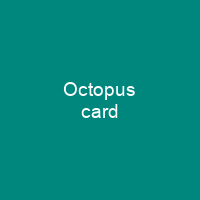The Octopus Card: A Journey Through Time
Imagine a world where your wallet is lighter, and transactions are smoother—welcome to the realm of the Octopus card. Launched in September 1997, this reusable contactless smart card has transformed Hong Kong’s payment landscape. But how did it all begin?
The Genesis of Octopus
In 1979, when Hong Kong’s Mass Transit Railway (MTR) started operations, they used magnetic stripe cards for fare payments. Fast forward to 1993, MTR Corporation announced a shift towards contactless smart cards. After three years of trials, the Octopus card was born on September 1, 1997. It quickly became a household name, with over three million cards issued in just the first three months.
A Rapid Expansion
The success of Octopus was not just about convenience; it was also driven by necessity. MTR and KCR required all holders of Common Stored Value Tickets to replace them with Octopus cards within three months or face expiration. By November 1998, the number of issued cards had soared to 4.6 million, reaching a staggering 9 million by January 2002.
From Transport to Retail
The Octopus card’s journey didn’t stop at transport; it expanded into retail transactions. In 2000, the Hong Kong Monetary Authority granted a deposit-taking company license to the operator, increasing non-transport-related transactions from 15% to 50%. Today, over 33 million cards are in circulation, used by 99% of Hong Kong residents.
Technological Innovations
The Octopus card uses Sony’s FeliCa RFID chip with a storage capacity of 1 to 64 kB. Data transmission occurs at up to 212 kbit/s, making it efficient and secure. The system pre-dates ISO/IEC 14443 standards using a nonstandard RFID system. It operates on a wide area network, connecting various components like turnstiles, add-value machines, and customer service terminals.
Security Measures
The Octopus card includes a fail-safe that prevents multiple cards from being detected at once. However, this feature has been abused for fare evasion by stacking multiple cards on the reader before breaking through turnstiles. Despite these challenges, security measures like encryption and mutual authentication between the card and reader ensure a secure transaction environment.
Future Innovations
Octopus Holdings Limited, a subsidiary of Octopus Cards Limited, has plans to introduce new technologies such as QR code payment and integration with Samsung Pay. These innovations aim to make transactions even more seamless and accessible for users.

Conclusion
The Octopus card has revolutionized payment systems in Hong Kong, transforming from a simple fare ticket into a versatile and widely accepted smart card. As it continues to evolve with new technologies, the question remains: How will this innovative system shape the future of payments?
You want to know more about Octopus card?
This page is based on the article Octopus card published in Wikipedia (retrieved on November 29, 2024) and was automatically summarized using artificial intelligence.







